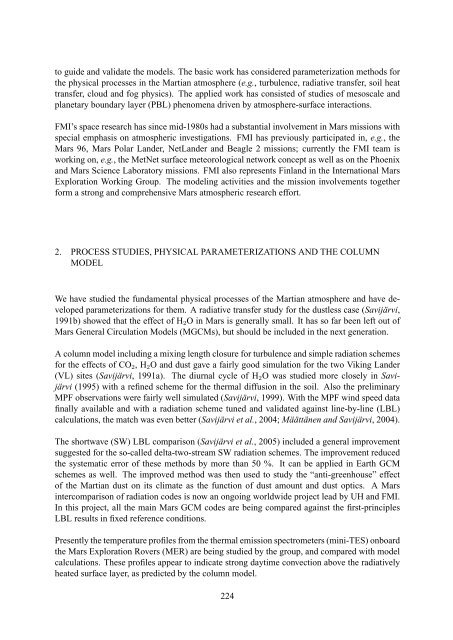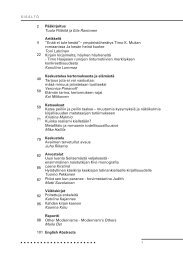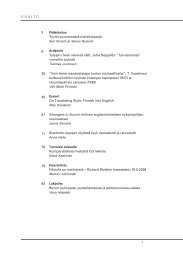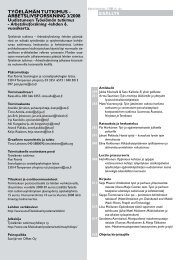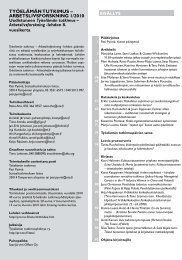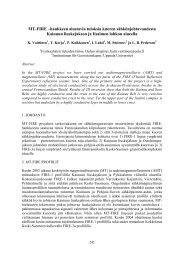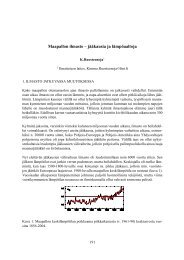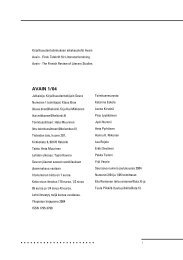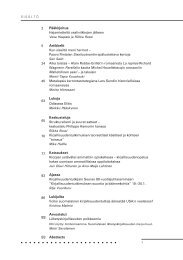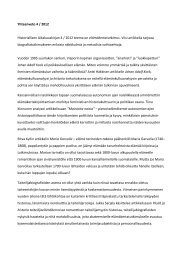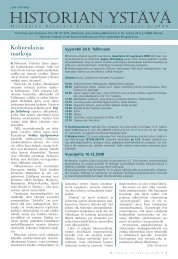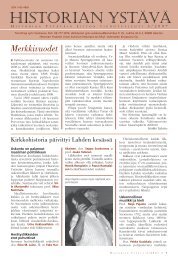Modeling of Martian atmospheric phenomena and atmosphere ...
Modeling of Martian atmospheric phenomena and atmosphere ...
Modeling of Martian atmospheric phenomena and atmosphere ...
You also want an ePaper? Increase the reach of your titles
YUMPU automatically turns print PDFs into web optimized ePapers that Google loves.
to guide <strong>and</strong> validate the models. The basic work has considered parameterization methods forthe physical processes in the <strong>Martian</strong> <strong>atmosphere</strong> (e.g., turbulence, radiative transfer, soil heattransfer, cloud <strong>and</strong> fog physics). The applied work has consisted <strong>of</strong> studies <strong>of</strong> mesoscale <strong>and</strong>planetary boundary layer (PBL) <strong>phenomena</strong> driven by <strong>atmosphere</strong>-surface interactions.FMI’s space research has since mid-1980s had a substantial involvement in Mars missions withspecial emphasis on <strong>atmospheric</strong> investigations. FMI has previously participated in, e.g., theMars 96, Mars Polar L<strong>and</strong>er, NetL<strong>and</strong>er <strong>and</strong> Beagle 2 missions; currently the FMI team isworking on, e.g., the MetNet surface meteorological network concept as well as on the Phoenix<strong>and</strong> Mars Science Laboratory missions. FMI also represents Finl<strong>and</strong> in the International MarsExploration Working Group. The modeling activities <strong>and</strong> the mission involvements togetherform a strong <strong>and</strong> comprehensive Mars <strong>atmospheric</strong> research effort.2. PROCESS STUDIES, PHYSICAL PARAMETERIZATIONS AND THE COLUMNMODELWe have studied the fundamental physical processes <strong>of</strong> the <strong>Martian</strong> <strong>atmosphere</strong> <strong>and</strong> have developedparameterizations for them. A radiative transfer study for the dustless case (Savijärvi,1991b) showed that the effect <strong>of</strong> H 2 O in Mars is generally small. It has so far been left out <strong>of</strong>Mars General Circulation Models (MGCMs), but should be included in the next generation.A column model including a mixing length closure for turbulence <strong>and</strong> simple radiation schemesfor the effects <strong>of</strong> CO 2 , H 2 O <strong>and</strong> dust gave a fairly good simulation for the two Viking L<strong>and</strong>er(VL) sites (Savijärvi, 1991a). The diurnal cycle <strong>of</strong> H 2 O was studied more closely in Savijärvi(1995) with a refined scheme for the thermal diffusion in the soil. Also the preliminaryMPF observations were fairly well simulated (Savijärvi, 1999). With the MPF wind speed datafinally available <strong>and</strong> with a radiation scheme tuned <strong>and</strong> validated against line-by-line (LBL)calculations, the match was even better (Savijärvi et al., 2004; Määttänen <strong>and</strong> Savijärvi, 2004).The shortwave (SW) LBL comparison (Savijärvi et al., 2005) included a general improvementsuggested for the so-called delta-two-stream SW radiation schemes. The improvement reducedthe systematic error <strong>of</strong> these methods by more than 50 %. It can be applied in Earth GCMschemes as well. The improved method was then used to study the “anti-greenhouse” effect<strong>of</strong> the <strong>Martian</strong> dust on its climate as the function <strong>of</strong> dust amount <strong>and</strong> dust optics. A Marsintercomparison <strong>of</strong> radiation codes is now an ongoing worldwide project lead by UH <strong>and</strong> FMI.In this project, all the main Mars GCM codes are being compared against the first-principlesLBL results in fixed reference conditions.Presently the temperature pr<strong>of</strong>iles from the thermal emission spectrometers (mini-TES) onboardthe Mars Exploration Rovers (MER) are being studied by the group, <strong>and</strong> compared with modelcalculations. These pr<strong>of</strong>iles appear to indicate strong daytime convection above the radiativelyheated surface layer, as predicted by the column model.224


